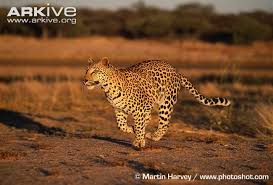Post by dinosauria101 on Jun 20, 2019 17:16:47 GMT 5
Leopard - Panthera pardus
The leopard, Panthera pardus, is a member of the Felidae family and the smallest of the four "big cats" in the genus Panthera, the other three being the tiger, lion, and jaguar. The leopard was once distributed across eastern and southern Asia and Africa, from Siberia to South Africa, but its range of distribution has decreased radically because of hunting and loss of habitat. It is now chiefly found in sub-Saharan Africa; there are also fragmented populations in Indonesia, Pakistan, India, Sri Lanka, Indochina, Malaysia, and China. Because of its declining range and population, it is listed as a "Near Threatened" species by the IUCN. Leopard are agile and stealthy predators. Although smaller than other members of the Panthera genus, they are able to take large prey due to their massive skulls that facilitate powerful jaw muscles. Head and body length is between 125 and 165 cm (49 and 65 in), and the tail reaches 60 to 110 cm (24 to 43 in). Shoulder height is 45 to 80 cm (18 to 31 in). The muscles attached to the scapula are exceptionally strong, which enhance their ability to climb trees. They show a great diversity in size. Males are about 30% larger than females, weighing 30 to 91 kg (66 to 200 lb) compared to 23 to 60 kg (51 to 130 lb) for females. Large males of up to 91 kg have been documented in Kruger National Park in South Africa; however, males in the South Africa's coastal mountains average 31 kg. This wide variation in size is thought to result from the quality and availability of prey found in each habitat. Smaller sized leopards also are known in the deserts of the Middle East. Its body is comparatively long, and its legs are short.

Wild Boar - Sus scrofa
Wild boar, also known as wild pig, (Sus scrofa) is a species of the pig genus Sus, part of the biological family Suidae. The species includes many subspecies. It is the wild ancestor of the domestic pig, an animal with which it freely hybridises. Wild boar are native across much of Northern and Central Europe, the Mediterranean Region (including North Africa's Atlas Mountains) and much of Asia as far south as Indonesia. dult boars measure 90–200 cm (35–79 in) in length, not counting a tail of 15–40 cm (5.9–16 in), and have a shoulder height of 55–110 cm (22–43 in). As a whole, their average weight is 50–90 kg (110–200 pounds), though boars show a great deal of weight variation within their geographical ranges. In central Italy, their weight usually ranges from 80 to 100 kg (180 to 220 lb) while boars shot in Tuscany have been recorded to weigh up to 150 kg (331 lb). An unusually large French specimen shot in Negremont forest in Ardenne in 1999 weighed 227 kg (550 lb). Carpathian boars have been recorded to reach weights of 200 kg (441 lb).

Credit to Wikipedia
The leopard, Panthera pardus, is a member of the Felidae family and the smallest of the four "big cats" in the genus Panthera, the other three being the tiger, lion, and jaguar. The leopard was once distributed across eastern and southern Asia and Africa, from Siberia to South Africa, but its range of distribution has decreased radically because of hunting and loss of habitat. It is now chiefly found in sub-Saharan Africa; there are also fragmented populations in Indonesia, Pakistan, India, Sri Lanka, Indochina, Malaysia, and China. Because of its declining range and population, it is listed as a "Near Threatened" species by the IUCN. Leopard are agile and stealthy predators. Although smaller than other members of the Panthera genus, they are able to take large prey due to their massive skulls that facilitate powerful jaw muscles. Head and body length is between 125 and 165 cm (49 and 65 in), and the tail reaches 60 to 110 cm (24 to 43 in). Shoulder height is 45 to 80 cm (18 to 31 in). The muscles attached to the scapula are exceptionally strong, which enhance their ability to climb trees. They show a great diversity in size. Males are about 30% larger than females, weighing 30 to 91 kg (66 to 200 lb) compared to 23 to 60 kg (51 to 130 lb) for females. Large males of up to 91 kg have been documented in Kruger National Park in South Africa; however, males in the South Africa's coastal mountains average 31 kg. This wide variation in size is thought to result from the quality and availability of prey found in each habitat. Smaller sized leopards also are known in the deserts of the Middle East. Its body is comparatively long, and its legs are short.
Wild Boar - Sus scrofa
Wild boar, also known as wild pig, (Sus scrofa) is a species of the pig genus Sus, part of the biological family Suidae. The species includes many subspecies. It is the wild ancestor of the domestic pig, an animal with which it freely hybridises. Wild boar are native across much of Northern and Central Europe, the Mediterranean Region (including North Africa's Atlas Mountains) and much of Asia as far south as Indonesia. dult boars measure 90–200 cm (35–79 in) in length, not counting a tail of 15–40 cm (5.9–16 in), and have a shoulder height of 55–110 cm (22–43 in). As a whole, their average weight is 50–90 kg (110–200 pounds), though boars show a great deal of weight variation within their geographical ranges. In central Italy, their weight usually ranges from 80 to 100 kg (180 to 220 lb) while boars shot in Tuscany have been recorded to weigh up to 150 kg (331 lb). An unusually large French specimen shot in Negremont forest in Ardenne in 1999 weighed 227 kg (550 lb). Carpathian boars have been recorded to reach weights of 200 kg (441 lb).

Credit to Wikipedia






